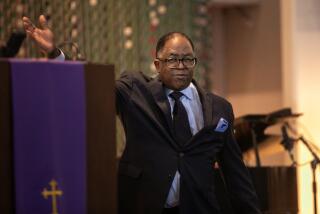Got discipline?
- Share via
WHAT ARE schools for?
For the last decade, I’ve taught a history course with that title at New York University. My students and I examine the different purposes that Americans have assigned to public schools, including:
A. to teach the great humanistic traditions of the West;
B. to develop the individual interests of the child;
C. to promote social justice;
D. to prepare efficient workers.
Over the last four centuries, Americans have struggled to balance these goals — and many others — in their schools. To Supreme Court Justice Clarence Thomas, however, there’s only one right answer:
E. to instill discipline and obedience
That’s what Thomas wrote this week in his strange concurring opinion in Morse vs. Frederick, better known as the “BONG HiTS 4 JESUS” case. A banner with those words was unfurled by senior Joseph Frederick outside his Alaska high school, and he was suspended.
Ruling 5 to 4 in favor of the principal who censored the banner, the court decided that the school’s interest in discouraging drug use outweighed the student’s free-speech rights. But Thomas went further, insisting that the student had no right to free speech in the first place and that the history of American education proves it.
He’s wrong. Simply put, the accurate history in Thomas’ opinion is not relevant. And the relevant history that he recounts is not accurate.
Let’s start with what he got right. As he correctly asserts, America’s first schools primarily promoted discipline. “Early public schools were not places for freewheeling debates or exploration of competing ideas,” Thomas wrote. The mostly male teaching force in the early 1800s brooked little or no dissent, often whipping children who challenged adult authority.
True enough. But so what? Here’s the part that Thomas leaves out. From the very birth of the common school system in the 1830s, the strict discipline that he celebrates came under fire from a host of different Americans. The most prominent champion of common schools, Horace Mann, warned teachers against excessive force and the suppression of students’ natural inclinations.
That’s one reason Mann and his generation backed the hiring of female teachers, who were seen as more kind, tolerant and nurturing. (The other reason was that schools could pay them less.) By 1900, roughly three-quarters of American teachers were women.
The early 20th century would bring another burst of change to American schools, centered on the question of democracy. To reformers like John Dewey, schools based on strict discipline — and its pedagogical companion, rote memorization — could never give citizens the skills they needed to govern themselves. Instead of fostering mindless obedience, then, schools needed to teach children how to make up their own minds — that is, how to reason, deliberate and rule on complex political questions.
To be sure, plenty of Americans still wanted teachers to bring the kids to heel. And it’s fair to ask whether schools today promote the kind of inquiry that Dewey envisioned.
The point is not that Dewey was “right” or that everyone agreed with him. Rather, history teaches us that Americans have always disagreed on the proper goal for schools.
None of this debate appears in Thomas’ opinion, which gets cut off just when things get interesting. To Thomas, American educational history seems to end at the start. Our first schools aimed to instill discipline, he wrote, so that’s what schools should do.
Worse, Thomas assumes that the schools succeeded in this task. “Teachers commanded,” he wrote, “and students obeyed.” But this command melted away in recent years, Thomas claims, when courts invented specious student rights — and “undermined the traditional authority of teachers to maintain order in the public schools.”
Here’s the part of Thomas’ opinion that would be relevant — if it were true. But it’s not. Yes, teachers tried to establish strict order and discipline in early American schools. As often as not, however, they failed.
Consider the 1833 memoir of Warren Burton, a New Hampshire minister. When faced with a particularly cruel teacher, Burton writes, his classmates revolted. They tackled the teacher, carried him outside and threw him down an icy hillside.
The theme appears in other memoirs and especially in fiction from the 19th century, which depicts unruly students — usually boys — challenging or mocking teacher authority. Think of Tom Sawyer lowering a cat by a string to snatch his bald teacher’s wig. Such stories resonated with Americans because they understood — in ways Thomas does not — the chaos and violence that pervaded so many public schools.
So Thomas can spare us the nostalgia. Our schools were never the paragons of discipline he imagines. And pretending otherwise simply diverts us from the big question, which will never have a single answer:
What are schools for?






